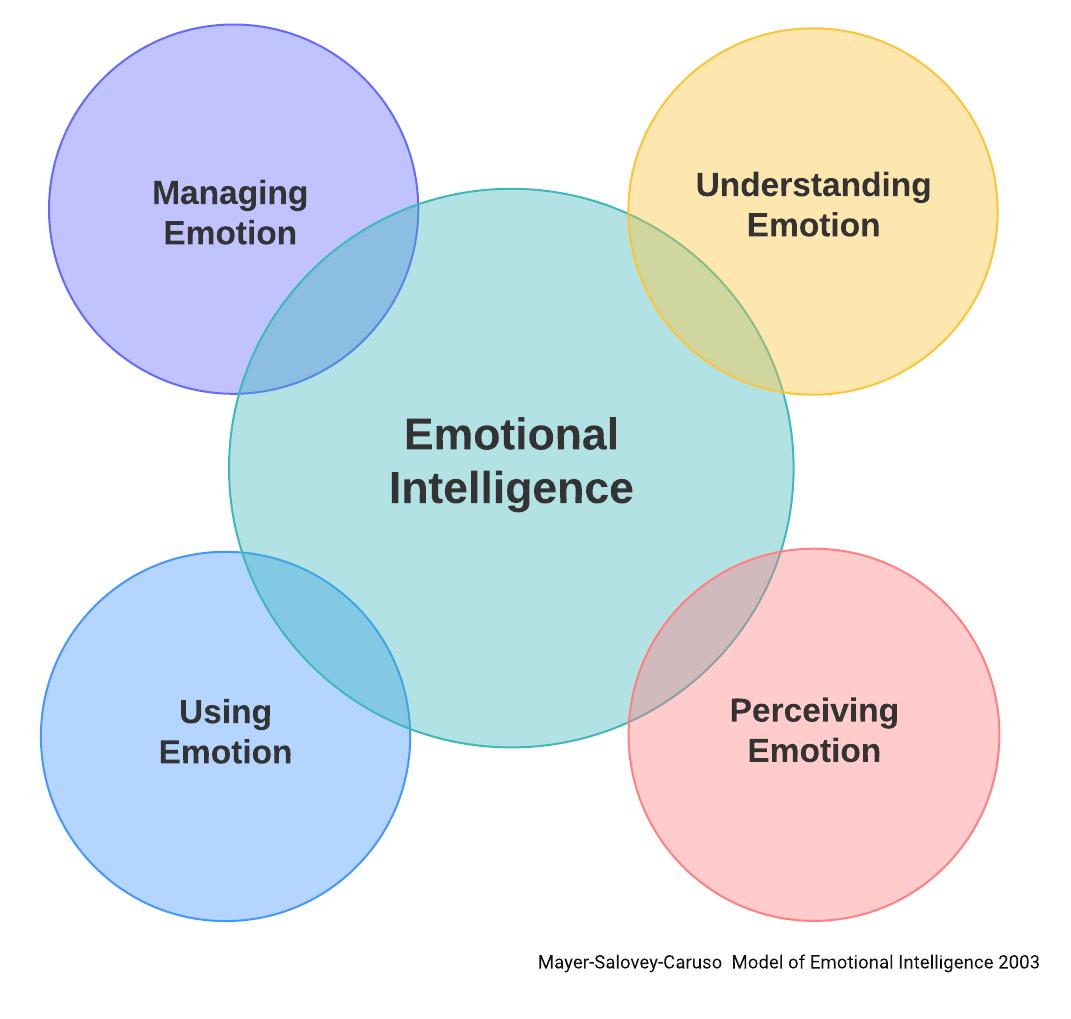

"All emotions are, in essence, impulses to act, the instant plans for handling life that evolution has instilled in us"
Daniel Goleman
Emotional Intelligence and Social Confidence are two related areas that have been increasingly linked with a young person’s wellbeing, especially in relation to performance, achievement and protective factors against mental health conditions.
Emotional intelligence
This has been defined as “the ability to monitor one’s own and others’ feelings and emotions, to discriminate among them and to use this information to guide one’s thinking and actions.”
(Salovey & Mayer 1989)
Emotional intelligence is relatively new concept that has been popularised by the work of Daniel Goleman. Goleman suggested that emotional intelligence is distinct from intellectual intelligence and fundamentally operates in two ways: awareness and management of one’s own emotions, and awareness and management of others’ emotions. More recent models have focused on four areas:
Perceiving Emotion – relates to the ability to interpret emotions in others through their body language, facial expressions and tone of voice.
Understanding Emotion – relates to an ability to work out why someone else might be expressing an emotion for example “why is this person angry, what is bothering them?”
Managing Emotions – relates to responding appropriately to internal emotions and to those of others.
Using Emotions – relates to our prioritising of attention to what we react and respond to.

We can see from these diagrams that emotional intelligence is a complicated process with several different areas of functioning required for us to successfully navigate the world around us. These processes encompass what emotional cues we perceive in others, our understanding that another person’s thoughts and feelings may be different from their own (theory of mind), our capacity to manage our own emotional regulation, and our ability to direct our emotion to completing tasks and goals.

Social Confidence
This refers to a young person’s ability to manage social interactions and connections. Children develop ways of coping with social interactions based on their early experiences around trauma. When a young person displays a lack of interest or ability to socialise, it is referred to as social withdrawal, defined as “the behavioural tendency to isolate oneself from peers” (Rubin, Coplan & Bowker, 2004)
Models of social withdrawal suggest that there are two dimensions of socially-withdrawn behaviour: an approach tendency (desire to interact with others) and an avoidance tendency (desire to avoid others).
Breaking social withdrawal into subtypes can help us understand that not all socially withdrawn children are simply uninterested in others, but rather may be struggling with the complicated aspects of social interactions. A shy child may struggle with the possibility of negative outcomes from a given interaction, whilst an avoidant child may have already embedded an idea of being inadequate and feel that they are undeserving of social interactions in the first place. An unsociable child, whilst not struggling with interactions or any internalised inadequacy, may simply not see the value of social interactions. Looking at social confidence and withdrawal in this manner helps us better cater for the problems with social interactions young people are facing.
Social relationships are critical for the maintenance of good health. Lev Vygotsky’s sociocultural theory of learning suggests that interacting with others is essential not only for learning but also for healthy cognitive development. Vygotsky suggested the idea of a “zone of proximal development” in which a child develops through their interaction with others, first learning through support and then being able to independently perform what they have learnt. This occurs on the academic, intrapersonal, social, and emotional levels, and allows the brain to develop itself by creating new pathways.
It is therefore quite easy to see how poor social confidence can lead to limited or impaired social interactions, which reduces opportunities for healthy cognitive development. Similarly, low levels of emotional intelligence can make interacting with others difficult and limits opportunities to build social confidence.

This is important to consider with children who may have diagnosed or undiagnosed neurodivergence and may struggle to understand their own emotions or interpret the emotions of others. This is also a particular problem for children that are yet unable or learning to speak English as they may struggle with communicating and maintaining friendships. It can be even more difficult for children arriving in the UK as refugees or asylum-seekers who may have language barriers and have experienced severe trauma and loss of family. Lastly, it is also important to consider how issues around diversity and gender identity may impact on a child’s social confidence.
All young people need exposure to situations in which they can develop emotional intelligence and build the social confidence to sustain meaningful, fulfilling relationships. Social withdrawal and the isolation that accompanies it is linked to a whole range of poor physiological and psychological outcomes including high levels of stress, anxiety and low mood and depression in children and adolescents, both at the time and in later life.
Teacher wellbeing
As with all matters of wellbeing, taking time to focus on areas such as emotional intelligence and social confidence helps to build an outlook that feeds into the interactions a teacher has with the young people they support. Whilst we are preparing ourselves to help others we must also look after ourselves. We’ve got some advice and guidance on this in the teacher wellbeing section.
Social and Emotional Wellbeing
Breaking down social and emotional learning into emotional intelligence and social confidence helps us to target specific areas a young person might be struggling with and reduce the risk of poor emotional intelligence and poor social confidence magnifying each other.
Emotional Support
A key part of contemporary theories of emotional intelligence is related to emotional regulation. For further advice and guidance on this, please see our emotional regulation section. Helping a young person learn to regulate themselves is a big step towards them being prepared to better direct and focus their emotions appropriately and advantageously to their continuing emotional development.
Talk about emotions
Talking about emotions in a safe, inclusive environment helps a young person identify and understand what their emotions are. As adults we take it for granted to be able to name, label and understand our emotions, but young people are still learning what emotions actually are. Giving young people an opportunity to name and consider emotions helps them to understand and practice dealing with emotions outside of when they are experiencing them.
Creating a short story that refers to emotions but leaves the names of the emotions blank allows pupils to try and decide and name what emotions the characters in the story are portraying. Pupils can do this on their own or together as a group.
Another exercise could be to have everyone sat in circle and ask them to talk about things that made them feel certain emotions, then using a set of pictures not clearly linked to emotions (e.g. places, artwork, animals etc.) ask the group to choose pictures that represent emotions. This should be quite easy for some emotions such as sadness (a picture of a rainy day) or happiness (a picture of the sun) but should be more interesting for emotions like worry or frustration. As a basis for this activity, you may want to use emotion cards.
It is common for young people to feel that emotions are something they have to hide, feel ashamed of and never talk about. The underlying goal of both of these exercises is to get young people thinking about emotions and how important it is for us to understand them in order to remain healthy.
Social Confidence
Social confidence is related to how we see ourselves in our interactions and is very much related to our self-esteem. Therefore, using techniques to improve self-esteem can often translate into improved social confidence.
Individuals
Directly improving social confidence for individuals can be tricky as it often involves exposing a young person with low social confidence to social situations. It is important to consider what level of interaction is most suitable so that a young person is not overwhelmed by the situation. For example, a low exposure social interaction might be to give a child a class role such as handing things out in the classroom for tasks, or a higher exposure and more interactive role might be for them to collect feedback from other children about a lesson. Also, remember to account for the difference types of social withdrawal and adapt exercises accordingly. An avoidant child will need much more personal support and encouragement prior to carrying out the interaction, but a shy child will need more support whilst carrying out the interaction.
Groups
Group work provides another opportunity for young people to develop social confidence, and can be easily mapped to other activities. An example might be to place pupils in small groups and give them a task to work on together (designing a piece of clothing/a party to celebrate the school’s anniversary). Then after completing the task in groups, get them to discuss as a class what went well and what problems occurred, with a focus on social confidence (for example, asking how the group felt when working together). Exploring this with the class then helps to identify what is important in positive social interactions, then carrying out another group task allows them to apply what they have learned to an interactive experience.

Emotional intelligence has been defined as “the ability to monitor one’s own and others’ feelings and emotions, to discriminate among them and to use this information to guide one’s thinking and actions” (Salovey & Mayer 1989). Social confidence refers to a young person’s ability to manage social interactions and connections.
All young people need exposure to situations in which they can develop emotional intelligence and build the social confidence to sustain meaningful, fulfilling relationships. Social withdrawal and the isolation that accompanies it is linked to whole range of poor physiological and psychological outcomes including high levels of stress in children and adolescents, both at the time and in later life.
Helping a young person learn to regulate themselves is a big step towards them being prepared to better direct and focus their emotions appropriately and advantageously to their continuing emotional development. Breaking down Social and Emotional Learning into Emotional Intelligence and Social Confidence helps us to target specific areas a young person might be struggling with. We have suggested and developed a number of activities around talking about emotions and building social confidence individually and in groups, which you can find in the Resources or Read More sections.
( resources found)





















How useful was this info?
Click on a star to rate it!
![]()
© Copyright Breathe 2020- 2024
Terms and Conditions | Privacy Policy
supporters & partners 



![]()
